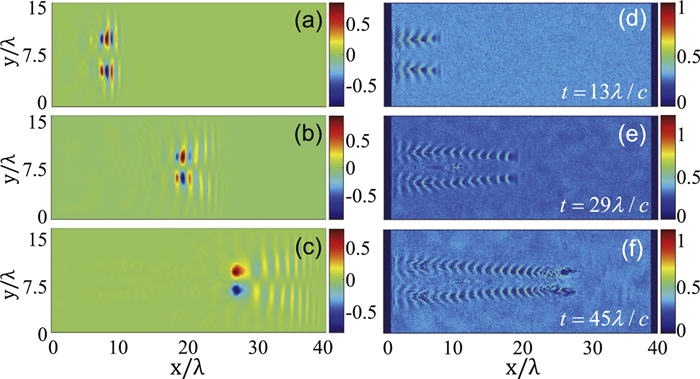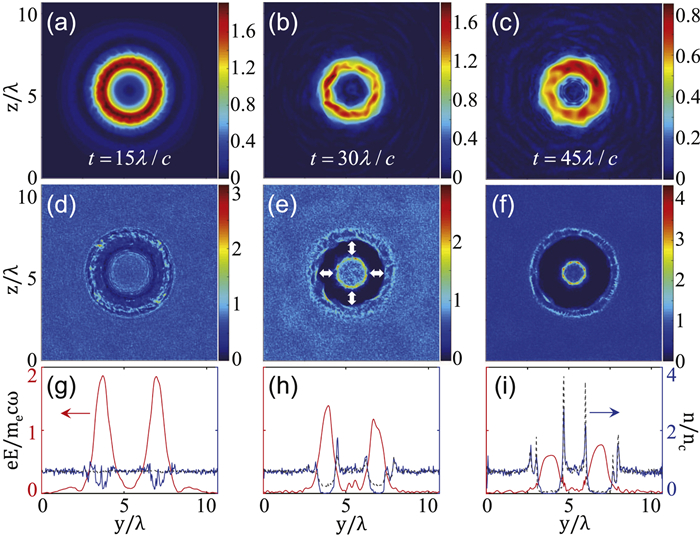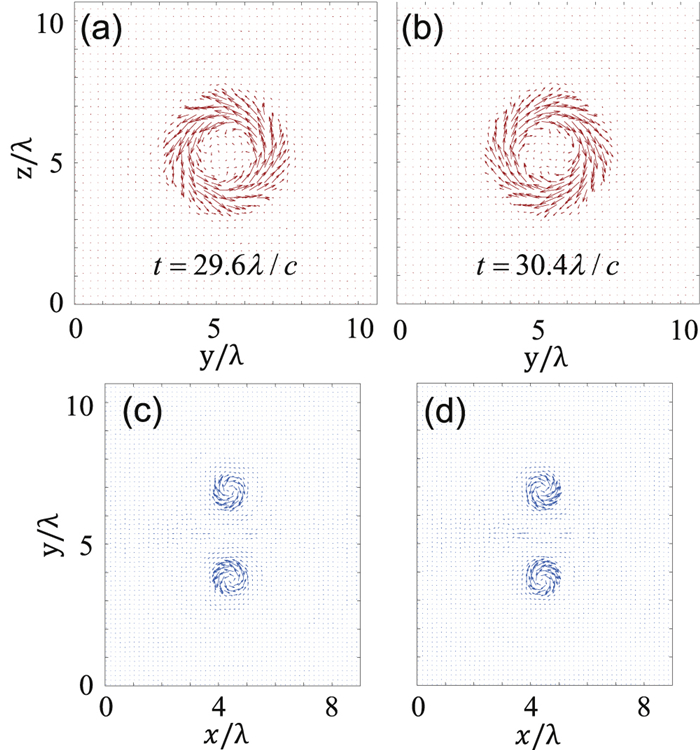
| Citation: | Zhongming CHENG, Dachao DENG, Mingyang YU, Huichun WU. Relativistic toroidal light solitons in plasma[J]. Plasma Science and Technology, 2023, 25(3): 032001. DOI: 10.1088/2058-6272/aca232 |
In the laser–plasma interaction, relativistic soliton formation is an interesting nonlinear phenomenon and important light mode convection in plasmas. Here, it is shown by three-dimensional particle-in-cell simulations that relativistic toroidal solitons, composed of intense light self-consistently trapped in toroidal plasma cavities, can be produced by azimuthally-polarized relativistic laser pulses in a near-critical underdense plasma.
The relativistic-laser interaction with plasma can generate radiations in the microwave to gamma-ray range, high-energy electrons and ions in the MeV to GeV range, as well as form relativistic solitons with extreme fields and plasma currents [1]. Compared with light solitons in optical fibers [2], relativistic solitons in plasma are highly nonlinear and can propagate slowly or even be at rest [3]. Relativistic solitons have been investigated analytically [4–10], numerically by particle-in-cell (PIC) simulations [11–17], and experimentally [18–22].
Two-dimensional (2D) PIC simulations [11–14] have shown that circular shaped s-type solitons formed in the laser–plasma interaction can be robust and stable [13]. The laser field in the s-soliton is trapped in a cylindrical plasma cavity and has a half-cycle standing wave mode. When propagating in plasma, the laser pulse loses energy, accompanied by a downshift in its frequency. For plasma density close to the critical density, much of the laser energy will be trapped in the cavity created by the ponderomotive-force expelled electrons, forming a soliton that is almost at rest. At longer times, plasma ions in the cavity are dug out by the charge-separation field, and the cavity becomes quasi-neutral, forming the so-called postsoliton. Similarly, p-type solitons can be formed by p-polarized lasers [11, 17], and are less stable than the s-solitons. The latter are more robust because their electric fields are always parallel to the plasma boundary, resulting in much weaker laser–plasma coupling and heating. However, s-solitons seem to only exist in 2D space.
Three-dimensional (3D) PIC simulations [15] show that relativistic solitons can have properties of both s-type and p-type solitons, but their postsoliton evolution is more like that of the p-type solitons. Moreover, circularly polarized laser pulses can form relativistic solitons that emit spiral electromagnetic waves [16]. In the postsoliton stage, the trapped laser electric field can also efficiently heat the plasma by vacuum heating [23, 24], leading to an implosion of the plasma cavity [13]. Experiments have confirmed the postsoliton stage of such relativistic solitons with circular plasma cavities [19–22]. In particular, Sylla et al [21] observed a train of ball-shaped postsolitons in the wake of the laser pulse. Several potential applications of these solitons have also been proposed, such as for ion acceleration [7] and attosecond pulse generation [25, 26].
As discussed above, in the postsoliton stage these 3D solitons behave like p-type [15], especially because there are always electric field components perpendicular to the inner surface of the 3D plasma cavity. Here, we propose an s-type-like 3D soliton with its electric fields always tangential to the inner surface of the plasma cavity. This can be accomplished by a torus plasma cavity, with the confined electric fields along the torus boundary. Such a laser–plasma configuration can be realized by an azimuthally-polarized laser, with a toroidally distributed and directed electric field, propagating in underdense plasma. A toroidal plasma cavity is then self-consistently produced by the pondermotive force of this doughnut-like laser pulse.
To verify our scheme, we carry out 3D PIC simulations by JPIC3d, which adopts a direct-splitting algorithm [27] to solve the Maxwell equations. This Maxwell solver is free of numerical dispersion along three xyz axes. An azimuthally-polarized laser pulse can be generated by several optical techniques [28]. Its electric field along the azimuthal direction ˆθ is given by
| Eθ=2√2E0rw0w(x)2exp[-r2w(x)2]f(t)×exp{i[kx-ωt-2φ(x)+kr22R(x)]}, | (1) |
where is the tranverse radius, is the beam width, is the pulse envelope, is the Gouy phase, is the wavefront radius, is the Rayleigh length, E0 and w0 are the field amplitude and the beam waist at the focal point, T is the pulse duration, and k = 2π/λ is the wave number. The magnetic field of the laser light is in the radial direction ˆr.
The laser pulse propagates in the x direction and focuses on the surface of a uniform plasma slab. The ion-to-electron mass ratio of the plasma is mi/me = 1836. The simulation cell is cubic, of size (0.05λ)3 and contains eight quasiparticles per cell. The time step is 0.05λ/c. The boundary conditions are periodic along the y and z axes and absorbing along the x axis for both fields and particles.
Figure 1 shows the propagation of an azimuthally-polarized laser pulse with normalized field strength a0 = eE0/mecω = 0.84 (corresponding to intensity I ~ 1.15 × 1018 W cm-2 for the 1 μm wavelength laser light), w0 = 3λ and T = 1λ/c in underdense plasma of initial density n0 = 0.3nc, where me is the electron rest mass, c is the light speed, and nc is the critical density. The laser pulse starts from the left boundary at x = 0 and focuses on the plasma surface at x = 2λ. In the x–y plane, the electric field along the z direction is s-type-like. The pulse contains about two light cycles and undergoes self-focusing in the plasma region x ∈ [2λ, 26λ]. The self-focusing is due to relativistic mass variation and electron expulsion by the pondermotive force [29, 30]. With increasing field strength, the toroidal laser beam shrinks in the transverse direction. In the underdense plasma, a ring-distributed plasma wave is generated in the wake of the laser pulse. Such plasma wakefields are nonlinear and have a curved wavefront [31].
With energy loss of the driving laser, its frequency decreases continuously due to photon number conservation [32]. The background plasma frequency is
Figure 1 shows that a toroidal s-type soliton can be formed by an azimuthally polarized laser pulse. The formation process is effectively adiabatic with gradual energy loss and frequency redshift. One can also enhance soliton formation by increasing the plasma density. Figure 2 shows a much faster formation process for a0 = 0.8 and n0 = 0.7nc, with the other parameters same as in figure 1. In this case, the plasma frequency is ωpe ~ 0.84ω, closer (than the preceding case) to the central frequency of the two-cycle laser pulse. Actually, the two-cycle laser pulse itself has a significant portion of energy spanned into the band of 0.84ω. Thus, the focusing laser pulse can form the electron cavity and gets self-trapped within a shorter propagating distance [33]. In fact, figure 2 shows that in a short propagation distance of ~3λ, about 35% of its energy is already trapped by the toroidal electron cavity. This nonadiabatic formation process is more efficient than the case in figure 1, since less light energy is spent driving the plasma wave in the propagation process.
Figure 3 presents the electric field amplitude
Figure 4 plots the electric and magnetic field vectors for the soliton in figure 2. We see that the electric field is azimuthally continuous in the whole toroidal plasma cavity. The electric fields in figures 4(a) and (b) correspond to two adjoining antinodes around t = 30λ/c (see figures 3(c) and (f)), and their directions are opposite. Within the toroidal cavity, the electric field is tangential to the cavity boundary, so that its interaction with the plasma is weak. The vortex magnetic fields in figures 4(c) and (d) always perpendicular to the toroidal electric fields. This field distribution is the same as the s-type soliton in 2D space [33].
Figure 5 shows the electric field Ey oscillation and the corresponding power spectrum in the soliton. The oscillation central frequency is about 0.66ω, which is less than the plasma frequency ωpe ~ 0.84ω of the background plasma, so that the electromagnetic field can be stably trapped by the cavity. For the postsoliton stage after t = 35λ/c, the light frequency further decreases as the laser energy is spent in widening the cavity.
These toroidal solitons should be close to a fundamental resonant mode without any nodes in an ideal toroidal cavity [35]. According to [35], the resonant angular frequency is given approximatively by 2.5c/rm, where rm is the radius of the so-called minor cross section of the toroidal cavity (i.e. the radius of the circular plasma channels in figure 2(f)). There are rm ≃ 0.46λ and 0.69λ for the plasma cavities in figures 3(e) and (f), respectively. The estimated resonant frequency is in the range of [0.58ω, 0.86ω], which can cover the spectral peak in figure 5(b).
The stability of our toroidal solitons is quite robust, mainly because the contained electric field is tangential to the inner surface of the cavity with much less plasma heating. In our simulations, we observe the stable soliton up to t = 150λ/c, which always remains the same field topology structure as discussed above. This soliton should be stable for a much longer time. Due to the continuous push by radiation pressure of the soliton field, the outer diameter of the cavity expands from 4.2λ at t = 30λ/c (figure 3(e)) to 6λ at t = 150λ/c. Meanwhile, the central plasma column shrinks from 2.3λ to 0.6λ in width. The action done by the light pressure consumes the significant energy of the soliton field, which decreases to eE/mecω = 0.04 at t = 150λ/c.
To further justify the robust formation of these toroidal solitons, we have carried out simulations for wider parameters. For example, if the laser pulse duration is doubled to T = 2λ/c with the other parameters unchanged, simulation shows that soliton formation occurs deeper in the plasma, namely at x ~ 11λ. This is because the pulse-intensity gradient (i.e. ponderomotive force) is much reduced and also the spectrum range is narrower for this longer pulse. On the other hand, if the laser amplitude is doubled to a0 = 1.6 with the other parameters unchanged, we found that multiple cavitations appear in the plasma, but eventually a complete toroidal soliton can still emerge. This scenario can be attributed to the much increased ponderomotive force that can lead to multiple local cavitations in the plasma. We also found that, by decreasing the plasma density with n0 = 0.5nc for a0 = 1.6, the soliton formation process is similar to that of figure 1.
In conclusion, we have shown that relativistic toroidal solitons composed of half-cycle intense light self-consistently trapped in toroidal plasma cavities can be created by azimuthally-polarized relativistic laser pulses in a near-critical-density plasma. The light electric field is mainly tangential to the boundary of the toroidal plasma cavity, so that the direct light-electron interaction is minimal and the soliton can survive for a long time. These new-topology solitons open a new option for potential applications based on conventional relativistic solitons.
This work was supported by the Strategic Priority Research Program of Chinese Academy of Sciences (No. XDA17040502).
| [1] |
Mourou G A, Tajima T and Bulanov S V 2006 Rev. Mod. Phys. 78 309 doi: 10.1103/RevModPhys.78.309
|
| [2] |
Agrawal G P 2001 Nonlinear Fiber Optics (San Diego, CA:
Academic)
|
| [3] |
Farina D and Bulanov S V 2005 Plasma Phys. Control. Fusion 47 A73 doi: 10.1088/0741-3335/47/5A/007
|
| [4] |
Lai C S 1976 Phys. Rev. Lett. 36 966 doi: 10.1103/PhysRevLett.36.966
|
| [5] |
Kaw P K, Sen A and Katsouleas T 1992 Phys. Rev. Lett. 68 3172 doi: 10.1103/PhysRevLett.68.3172
|
| [6] |
Esirkepov T Z et al 1998 JETP Lett. 68 36 doi: 10.1134/1.567817
|
| [7] |
Farina D and Bulanov S V 2001 Phys. Rev. Lett. 86 5289 doi: 10.1103/PhysRevLett.86.5289
|
| [8] |
Lehmann G, Laedke E W and Spatschek K H 2006 Phys. Plasmas 13 092302 doi: 10.1063/1.2338820
|
| [9] |
Sanchez-Arriaga G and Lefebvre E 2011 Phys. Rev. E 84 036403 doi: 10.1103/PhysRevE.84.036403
|
| [10] |
Sanchez-Arriaga G et al 2015 Phys. Rev. E 91 033102 doi: 10.1103/PhysRevE.91.033102
|
| [11] |
Bulanov S V et al 1999 Phys. Rev. Lett. 82 3440 doi: 10.1103/PhysRevLett.82.3440
|
| [12] |
Sentoku Y et al 1999 Phys. Rev. Lett. 83 3434 doi: 10.1103/PhysRevLett.83.3434
|
| [13] |
Naumova N M et al 2001 Phys. Rev. Lett. 87 185004 doi: 10.1103/PhysRevLett.87.185004
|
| [14] |
Sanchez-Arriaga G and Lefebvre E 2011 Phys. Rev. E 84 036404 doi: 10.1103/PhysRevE.84.036404
|
| [15] |
Esirkepov T et al 2002 Phys. Rev. Lett. 89 275002 doi: 10.1103/PhysRevLett.89.275002
|
| [16] |
Esirkepov T et al 2004 Phys. Rev. Lett. 92 255001 doi: 10.1103/PhysRevLett.92.255001
|
| [17] |
Singh D K et al 2012 Phys. Plasmas 19 073111 doi: 10.1063/1.4737151
|
| [18] |
Borghesi M et al 2002 Phys. Rev. Lett. 88 135002 doi: 10.1103/PhysRevLett.88.135002
|
| [19] |
Sarri G et al 2011 Phys. Plasmas 18 080704 doi: 10.1063/1.3625261
|
| [20] |
Zhu B et al 2012 Phys. Plasmas 19 102304 doi: 10.1063/1.4757982
|
| [21] |
Sylla F et al 2012 Phys. Rev. Lett. 108 115003 doi: 10.1103/PhysRevLett.108.115003
|
| [22] |
Blackman D R et al 2021 Plasma Phys. Control. Fusion 63 074001 doi: 10.1088/1361-6587/abf85c
|
| [23] |
Brunel F 1987 Phys. Rev. Lett. 59 52 doi: 10.1103/PhysRevLett.59.52
|
| [24] |
Gibbon P and Bell A R 1992 Phys. Rev. Lett. 68 1535 doi: 10.1103/PhysRevLett.68.1535
|
| [25] |
Isanin A V et al 2005 Phys. Rev. E 71 036404 doi: 10.1103/PhysRevE.71.036404
|
| [26] |
Bulanov S S et al 2006 Phys. Rev. E 73 036408 doi: 10.1103/PhysRevE.73.036408
|
| [27] |
Wu H C 2011 arXiv: 1104.3163
|
| [28] |
Zhan Q 2009 Adv. Opt. Photon. 1 1 doi: 10.1364/AOP.1.000001
|
| [29] |
Sun G Z et al 1987 Phys. Fluid 30 526 doi: 10.1063/1.866349
|
| [30] |
Lin Z et al 2018 J. Opt. Soc. Am. B 35 1415 doi: 10.1364/JOSAB.35.001415
|
| [31] |
Esarey E, Schroeder C B and Leemans W P 2009 Rev. Mod. Phys. 81 1229 doi: 10.1103/RevModPhys.81.1229
|
| [32] |
Reitsma A J W et al 2006 Phys. Plasmas 13 113104 doi: 10.1063/1.2366577
|
| [33] |
Wu H C 2016 Sci. Rep. 6 28263 doi: 10.1038/srep28263
|
| [34] |
Quesnel B and Mora P 1998 Phys. Rev. E 58 3719 doi: 10.1103/PhysRevE.58.3719
|
| [35] |
Janaki M S and Dasgupta B 1990 IEEE Trans. Plasma Sci. 18 78 doi: 10.1109/27.45509
|
| 1. | Wang, X., Luo, Y., Wu, J. et al. Modulational Instability of Arbitrary Intense Lasers in the Relativistic Hot Electron-Positron Plasma. Journal of the Physical Society of Japan, 2024, 93(12) DOI:10.7566/JPSJ.93.124501 |
| 2. | Deng, D.-C., Wu, H.-C. Compression and acceleration of ions by ultrashort, ultraintense azimuthally polarized light. Physical Review E, 2024, 109(6): 065211. DOI:10.1103/PhysRevE.109.065211 |

